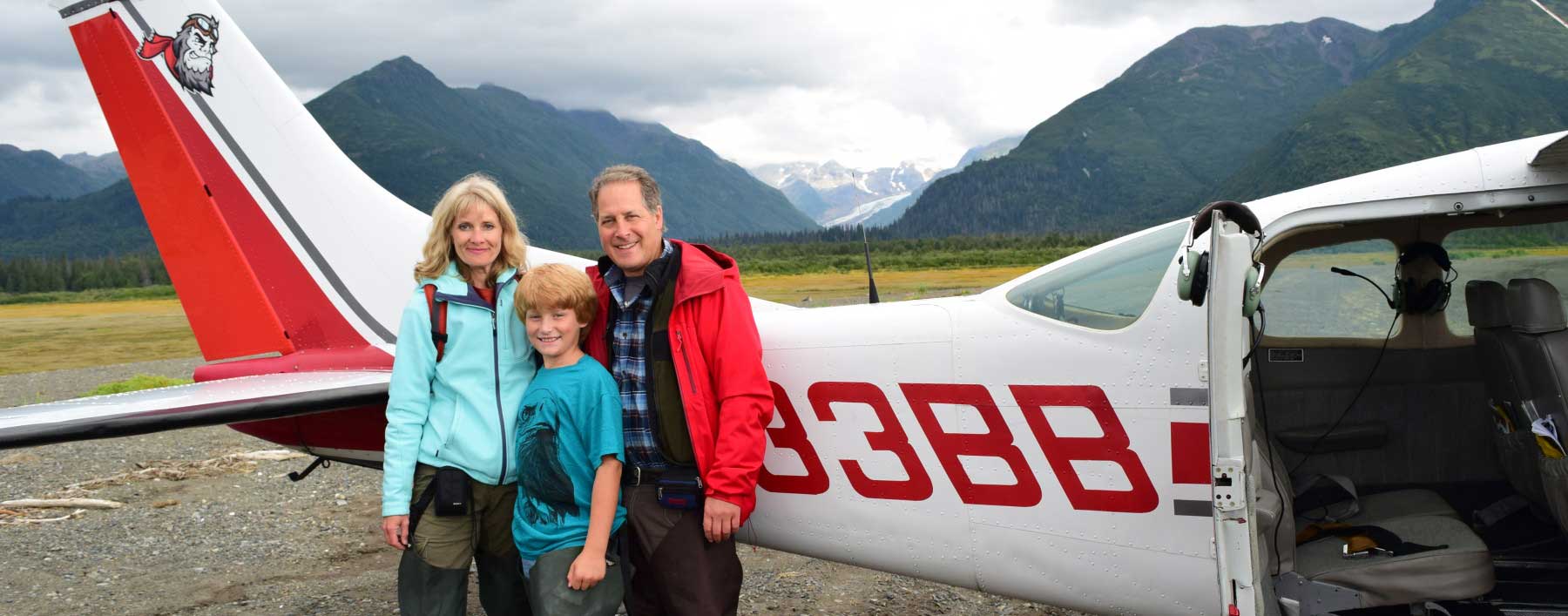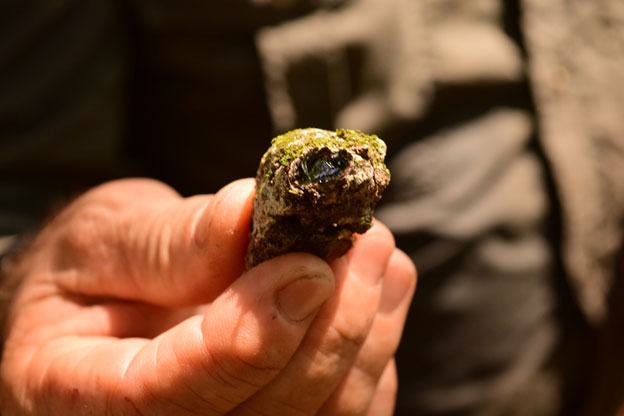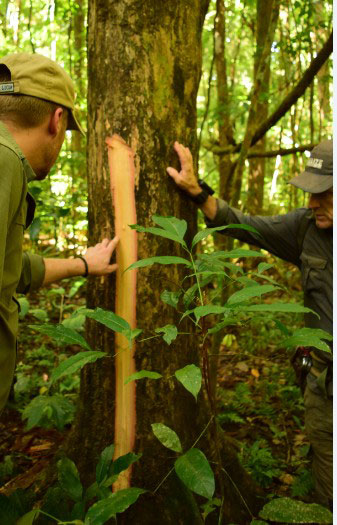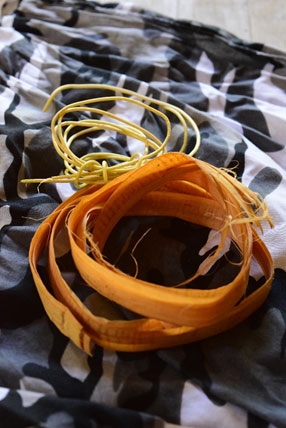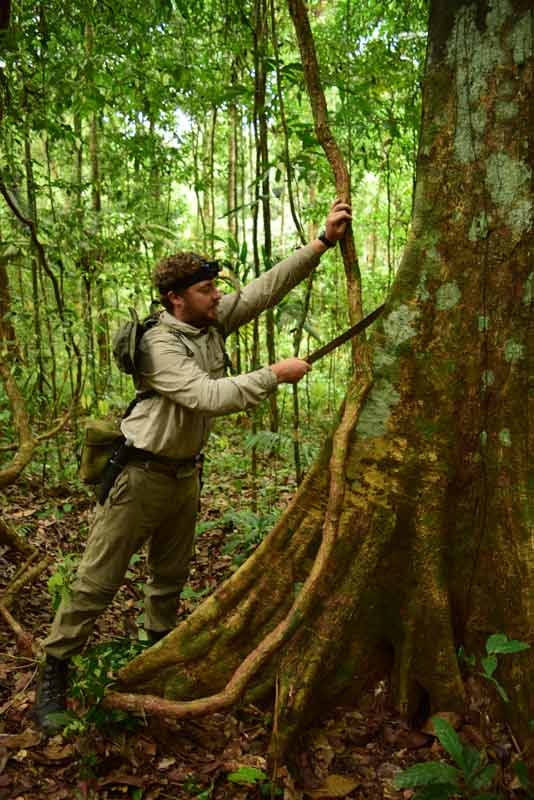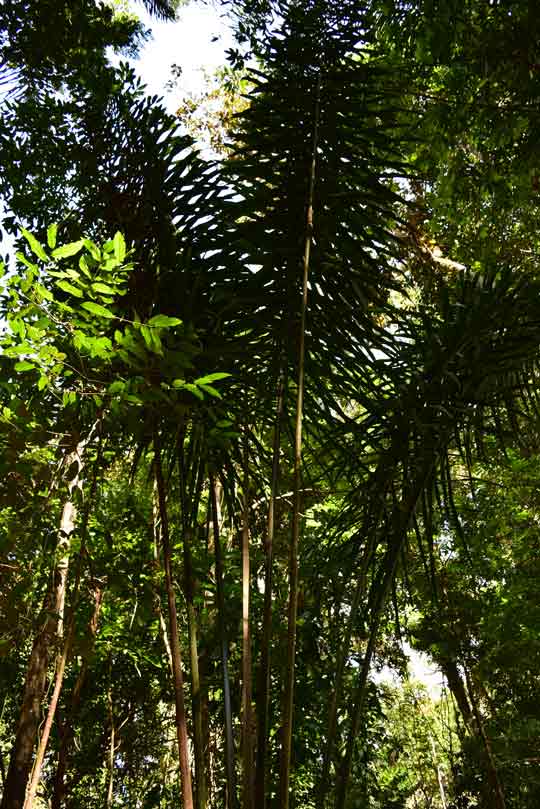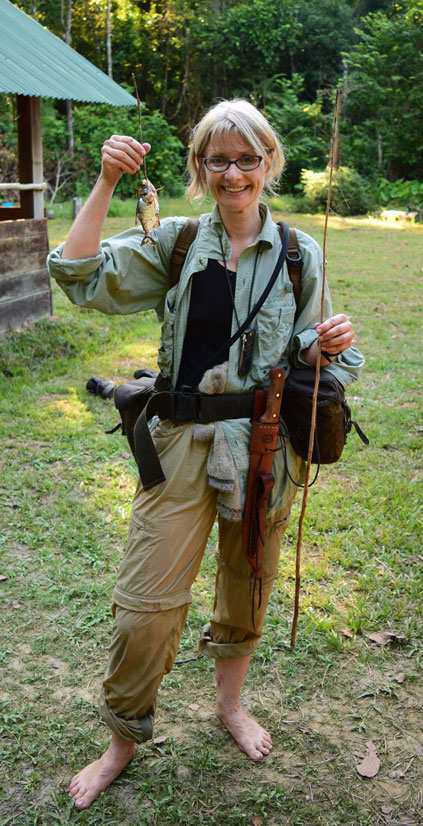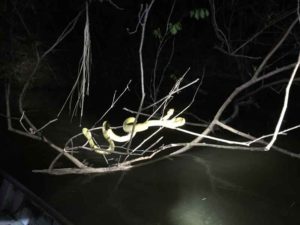7:00 breakfast, 8:00 bow hunting practice. Today Ian tells us that we need to be able to put an arrow on the string by feel alone, without looking: “you will never see the whole animal, only a small part of it, so your target is very small, and if you look away to look at your bow, you will never find your target again.”
So, we need to grab the arrows together with the bow, balanced in the center, tips facing forward, ready to shoot at any time (as opposed to yesterday where everyone had the arrows sticking in the ground). Left hand holds the bow balanced in the center, right hand reaches over and grabs an arrow and, without looking, we put it on the bowstring, fitting the nock to the string and use our index finger to guide where the arrow should go.
 I practice shooting into the ground, rather than the target to get more practice. Lionel comes over and teaches me to hold the bow tilted, not straight like a recurve bow. And to not pull the string far back, but just a little. He says in the jungle you are almost always crouched, not standing upright, and you likely have no space to pull back far on the bow string, so learn to just pull back a little and the arrow will actually go farther.
I practice shooting into the ground, rather than the target to get more practice. Lionel comes over and teaches me to hold the bow tilted, not straight like a recurve bow. And to not pull the string far back, but just a little. He says in the jungle you are almost always crouched, not standing upright, and you likely have no space to pull back far on the bow string, so learn to just pull back a little and the arrow will actually go farther.
Sounds counter intuitive, but it seems to work. When I pull back just a little, my arms don’t tremble and the arrow goes much further. I still miss the target, but he says accuracy will come over time.
Do we have what it takes?
Our morning lecture today is about survival, about the four factors that allow some people to survive and others not. Ian has 10 cans of mixed vegetables stacked out on the table in front of him. Del Monte again, LOL? But this morning it’s just a prop. He says the four factors build on one another, like a pyramid. He sets up the base:
- 4 cans on the bottom: represent motivation. THE most important thing. Whatever motivates you to get through the experience. Could be that you want to survive because you have small kids who need you. Or a business you cannot abandon. Or a pot of gold at the end of the rainbow if you make it through. Or your faith. Whatever it is. — Ian later asks me what my motivation is. I tell him I just want to fucking do it and see it through. He nods: “sheer bloody-mindedness. That works too!”
- 3 cans on top of the bottom four: physical fitness and robustness. The next most important thing. It’s the physical shape you’re in, couch potato vs marathon runner; but also, whether you are healthy or have sustained an injury during your survival situation. And it’s also how you deal with physical adversity: Ian tells the story of the ultra marathoner on one of his trips who was super fit, but once blisters hit, they sort of fell apart.
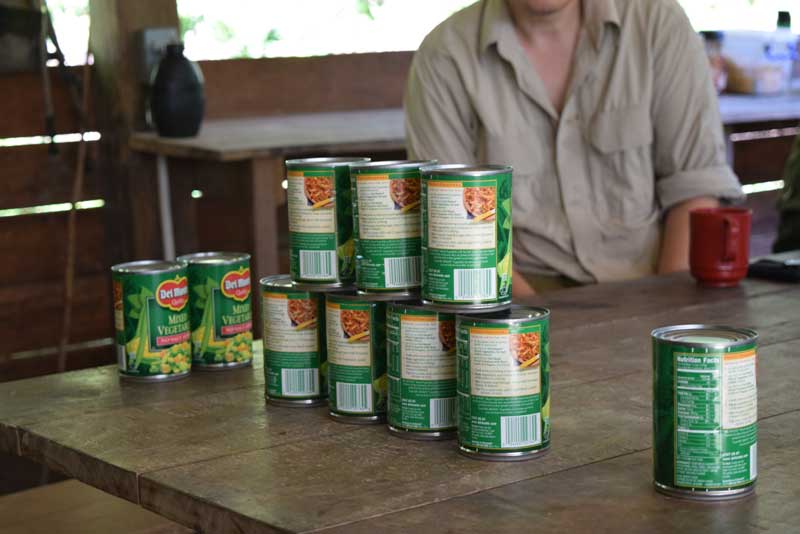
- 2 cans on top of the three: knowledge and skills. What we’re getting in this course. You can read a book. Or watch Youtube videos. You can even watch the tv show “Naked and Afraid.” If you’ve read it, watched it, heard about it, and you think it might help, try it.
- 1 can on the top of the pyramid: survival tools. The stuff we have in our belt kit. — “You don’t need much, but what you need, you really need, and you must look after, always.”
By now we have a full belt kit: the left pouch contains a plastic tube with cotton balls for fire starting, and a Swedish fire steel tied to the belt (“I cannot tell you how many Naked and Afraid contestants use the fire steel and then lose it and have to watch the fire every second for the next 20 days so it doesn’t go out! – I want you to tie the fire steel to the belt kit and do not take it off!”).
We have another container with a head net and our iodine to purify the river water. And one with the fishing hooks and extra fishing line in case we lose our yariyari rod. And a wooden spindle with stronger line and a bigger hook, our longline. And about 5 meters of paracord. And a compass and an emergency whistle.
And finally, bug spray. (I only used a little twice on the entire trip. Turns out, it was a lot less buggy than I expected and the long pants and long sleeves, and maybe the permethrin clothes, worked well for me.)
The right pocket of the belt kit has our water bottle and cup, and, as of tomorrow morning, will also contain a spoon. And of course, the belt kit has the machete. And we will be able to take our folding knife into isolation.
Making our Cooking Utensils…
Our next activity is to make a bamboo cook pot. (Cook pot, huh? That implies they think we’ll actually get enough food to want to cook something – not sure if that is just wishful thinking or if it should give me hope, LOL).
Lionel and Derrick have harvested several thick bamboo stalks somewhere. We each get to cut a section off with our machetes. At each “node” the bamboo is closed and will hold water. We basically cut part of the piece to the left of the section node and a part of the piece to the right of the section node off to make “handles” that you can set on sticks by the fire so the cook pot hangs suspended between the sticks over the fire.

Then we hack V notches on each side on the inside of the nodes, just deep enough to get to about half the diameter of the log. By twisting the machete, we are able to drive a crack down the center of the section that becomes the lid for the cookpot.
So now you can fill it with water, then put the lid back on and set it on sticks over the fire. Lionel says we should be able to use it 4-5 times to boil water until it becomes too charred to use. 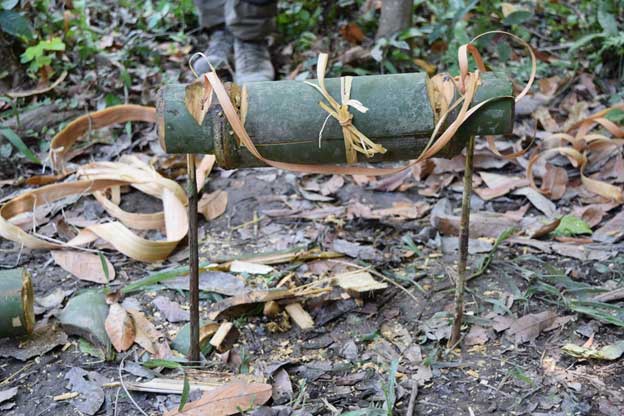 At that point, you can still use it to carry things, like embers for your fire, when you’re on the move, or for holding food.
At that point, you can still use it to carry things, like embers for your fire, when you’re on the move, or for holding food.
Making the cook pot required a lot of machete work. I had been sharpening my machete early in the morning, after breakfast, because we had been told that we needed sharp machetes today. I was really worried about somehow sharpening my machete wrong. Ian came over and showed me again.
I was comparing the main cutting area of the machete with the end piece that had never been sharpened and the end piece looks much sharper and less broad and curvy, so I was afraid my machete was already messed up. Ian assured me that it is not, that in fact it needs to be sharper: the end piece he said is shaped differently because that is where they hold and clamp the metal, so it is actually thinner there than elsewhere on the machete. No reason to panic. 🙂
I think machete sharpening is the most important skill for me to learn: I will need it for shelter building, where I have to cut down countless trees; I will need it for fire making (cutting down dead trees, and for making feather sticks); and I will need it for opening kukrit grubs for either fishing or eating.
If my machete is not properly sharp, everything will take me longer and will be harder. I don’t need that, not having all that much strength to begin with. I have said that to Ian a few times and he always gives me “the look” and then says, “it’s not strength, it’s technique!” Yes, yes, it is. But you can’t tell me that strength doesn’t also matter. At least a little.
When I hit a tree with my machete, I need to chop 50 times before it comes down, beaver chewing my way around it. I see Ian and the other guys: they chop maybe 15 or 20 times. So I say that to Ian. Not complaining, just being factual. And he says, “well, this isn’t happy camping, it’s survival! … And sometimes it’s just HARD!” Yup.
The SIX most useful jungle plants
After lunch, we go for a “walkabout,” about a 2-hour hike through the forest near our camp, where we learn to identify 6 useful plants.
Locust tree.
Big tall tree, but not a large buttress on the bottom. Gives us kapok in the rainy season (basically the rain forest equivalent of cotton wool that can be used as tinder). Year round, you can find the resin on the ground near the trunk and under the branches: the resin is very flammable and helps you sustain a hotter, brighter fire for a while. We can take into isolation what we forage for today, so I’m happy to find a bunch of resin pieces.
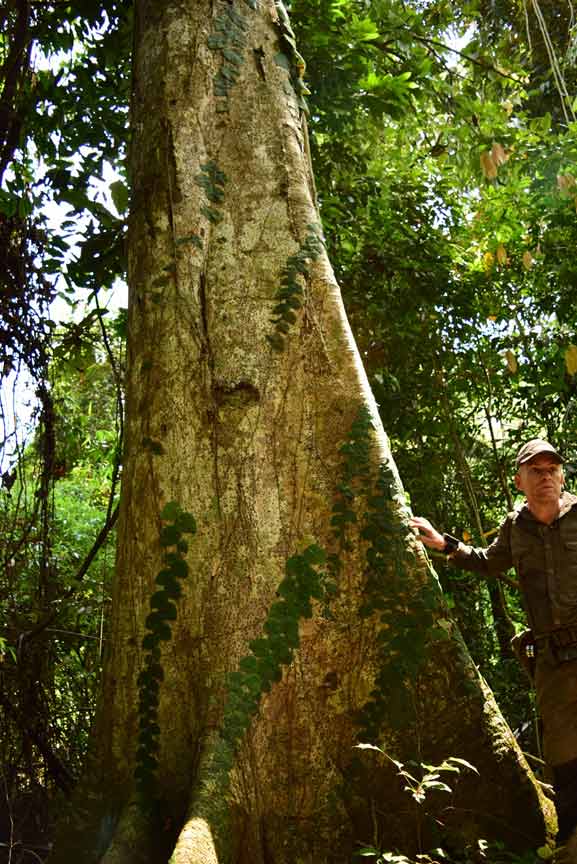
Silk cotton wood tree. Very tall and majestic looking. Serves as a location marker. (Sadly, I have no picture.)
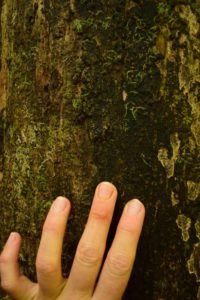 Stevie Wonder tree (not it’s real name, but what Ian calls it): the bark of the tree has lots of little bumps that look like braille, hence the name Stevie Wonder tree.
Stevie Wonder tree (not it’s real name, but what Ian calls it): the bark of the tree has lots of little bumps that look like braille, hence the name Stevie Wonder tree.
Make a cut into the outer layer of the bark and then another cut behind it to get into the inner layer and then peel both down (not pulling outwards, but pushing downwards).
The inner layer is very strong cordage that can be used to make backpacks, lash shelter, beds, anything, pretty much, that you might otherwise use paracord for.
You can pull the layers and strands apart until you have it about finger width wide and one or two layers thick.
Water vine: looks like a “sunburned English tourist’s skin: red and flaky”. The vine grows from the top down. Make the first cut up high, then quickly make the second cut low and hold the cut off piece horizontally. Tilt to drink: should look and flow like water. If it is milky and colored, it is not water vine. C volunteers to take down a piece of water vine and I drink from it. Tastes pretty good. Like water but with an earthy taste, sort of like dirt. Drinkable.
Kukrit Palm: all stages are useful. Baby Kukrit has nice big leaves that you can use to wrap up little bait fish for steaming over your fire (if too small, they’ll burn on a stick). Teenage Kukrit grows in a clump with tall fronds and strong stalks. Use the fronds for the roof of your shelter and the stalks for the mattress. And adult kukrit: gives us the kukrit nuts. Also called tree of life, because it is so useful in all its stages.
Heart of Palm.
The only food that you have available 24/7. Several species have a harvestable heart of palm, although they vary in how much you get. Best is the heart of palm tree, single tree, long thin light green leaves (as opposed to kukrit leaves which are a bit broader and darker and shaggier).
Reef palms also yield heart of palm but grow in clumps and have less heart of palm. Finally, the spiky black palm also has some heart of palm although getting at it is brutal, what with the spikes and all. Crux is that in order to get the heart of palm, you have to take down the entire tall tree. We don’t really see a good example on this walk but he says we’ll do another walk at the other campsite where we’ll see more.
The big one that got away
More opening nuts in the afternoon, and more fishing. This time I’m on land. We decide to fish off the rocks where the other team has had good success yesterday. The water has gone down noticeably since yesterday, so sitting on the rocks, our yariyari fishing lines barely reach into the water. The whole bank is covered in slimy mud and it’s steep. I finally crouch on the slippery mud-covered rocks, leaning back in order not to slide in, and start fishing.
I briefly think about taking my belt kit off, but there is no good place to hang it. And my boots. I know my hiking boots don’t grip well in the mud and I feel like I could do a lot better with my bare toes. But who knows what hidden dangers lurk in the mud, so I keep them on.
I get a lot of nibbles, a lot of tugs on the line. At first, I used to always yank the line out at the first sign of tugging, and would get no bites. Then I tried leaving the line in longer, making sure the fish have time to swallow the bait and the hook.
That usually resulted in me losing my half grub bait pieces, and pulling out an empty hook – the little bastards ate the bait off but didn’t swallow the hook! Well, these are piranhas we’re fishing for here, so not surprised they’re nibbling off the bait.
And then there are the in-between cases, where you pull the line out, you have a fish on the line, but, since it’s not firmly attached, you lose it as you pull the fish out of the water and it falls back in. So frustrating. I cannot see how some people do this for relaxation. Well, maybe it’s relaxing when you have your cooked meal waiting for you, but I don’t find the idea of losing my fish, or my bait, relaxing, given that in a few days I’ll be relying on this skill for eating in isolation.
Finally, I get a bite and I swing a fish out onto the bank! Whoohoo! A (smallish) red-bellied piranha!! Got you, SUCKER!
Later, I catch another one, longer, thinner. I think Derrick calls it a skell fish (sp?).
My first two fish! I lose one more as I pull it out. And then, the big one bites! Well, bigger anyway: I land a hand sized piranha, and swing it out onto the top of the embankment. Three fish. I rock!
The piranha flops around madly and somehow loosens the hook…and is free! In its mad flopping, it starts sliding down the muddy bank and I grab for it, but it’s just out of my reach; I lean over and grab again, and again, lower…and lose my center of gravity! I am now in a slow but inevitable slide down the slippery rock surface, headed for the river.
I go down in a fantastic splash, boots and belt kit and all! Damn! I’m more pissed than anything else. The river is deep here, and I cannot stand and there is a bit of a current, but I can still hold on to the rocks. I’m ok for the moment, but how do I get out? There are several vines snaking down the rocks, near the water, but since our boys have used these during bathing a few times, they are not in great shape.
The guys tell me to grab the big vine, but it is broken and attached only with the thinnest layer of bark. Doesn’t look safe to me. I can totally see how I’m heaving myself out of the water, clutching the vine, and then, just as I’m trying to gain purchase on the slippery rocks, the vine gives and I fall back into the river. Uh, no.
Really, the better question is: how do I even get up on the rock, before I can grab the vine? With my sopping wet clothes and boots, and my belt kit and machete, I am so heavy that my already sore arm muscles cannot get me high enough up out of the water for my tired thigh muscles to lever my weight onto to the rocks (which are still slippery, mind you, and mud covered).
I allow myself a moment of freakout time. I’m in the fucking river and I can’t get out. The first time the “Life Alert” thing happened (“help! I have fallen and I can’t get up!”), it was funny. This time it’s not. I’m in the freaking river and I cannot get myself out. I mean, there are a bunch of people with me, and it’s not like I’m going to drown here, but I have to fucking pull myself together and get out. I don’t want to be the weak link, the person in the group that other people always have to watch out for.
If this happens in isolation, when I’m all by myself, I either get it figured out or I’m dead! — I’m working through my anger. No, I won’t fish here again. Yes, I should have taken my boots off when I thought about it and I probably would not have fallen in, but right now, I need to get myself OUT.
I take a step back in my mind and use logic. First, I lighten my load by taking the belt kit off and handing it to Derrick. Then I untie my boots in the water and take those off, then my socks, and hand those to him as well. Much lighter and in grippy bare feet, I grab a vine and am finally able to pull myself out, all by myself. Digging my bare toes into the mud like crampons, I get up the bank and am finally safe. Just wet. Dripping, sopping wet.
Well, I guess that takes care of “bathing” for the day! I’m done fishing and everybody else packs up as well and we drop off our bait fish in the shed. Bath time!
I skip the official bathing and move on to the next activity on the program: making a fire by my basha. I make a small, hot fire and roast my dripping boots. I take the insoles out and wring them out, then open the laces of the boots as wide as possible and pull the tongue out to let as much heat get to the inside as possible.
Ian says wet feet can lead to trench foot (foot rot) within a day (starts with itchy spots on your foot and then your skin turns white and comes off in big chunks. Yum.) That’s why we were told to bring anti-fungal foot powder. I haven’t used mine yet, and I really don’t want to, so I have to get these boots dry enough by 8:00 am tomorrow morning to use them again. I experiment with different sticks to impale the boots on to let them drain out, but they all just expose the outside of the boots to the heat. The key is to get the inside dry. So I lay them on their sides, propped up and held open by an elaborate stick construction. I baby the fire until it’s time for dinner.
Dinner this evening is pasta, farine, and mystery stew with Del Monte. I think it’s a different protein every day, but honestly, it all sort of tastes the same. But hey, I didn’t have to hunt or trap or fish for it, and someone else has cooked it and it’s hot and provides calories.
Today is my turn for night fishing. We have a half hour after dinner to get ready. We can wear our dry night clothes and crocs. I build up my fire some more and, in an unguarded moment, manage to burn (melt) the lining of my right boot a bit. Oh well. I pull the boots to a safe distance and build up the fire to where it should provide enough heat to dry but hopefully not burn the boots. Then I grab my head torch and go down to the boat. We paddle and drift with the current for a long time, looking for animals. Maybe a labba to hunt. Or a snake to pull down and touch. Maybe a caiman.
In the beams of the strong headlamps Ian has given us we can occasionally see eyes reflecting the light back from the banks. Rats. Possums. Eyes in trees are probably snakes. Ian spots a snake in a tree that’s in the water.
We bring the boat close and he climbs into the tree and uses his hooked snake stick to grab the snake and bring it down. It winds itself around his left wrist as he is talking to us about tree boas. This one might bite but it kills its prey by squeezing it to death. It’s a pretty greenish yellowish color with black. Ian says it just shed. It’s a corkscrew boa; closely related to the Amazonian tree boa, but that one is more orange-y.
Ian says it’s really squeezing him now and he removes it from his wrist and lets the snake slither through his hands. He explains that the snake is now anxious and wants to get away. Letting it slide through your hands and then grabbing it again with the other hand, the snake feels like it is making progress, moving on a warm surface, and that calms it down. So he hands it to S, then to P, and eventually I get it. It feels like other snakes I have touched. Smooth, neither warm nor cold, and very much eager to be gone. I hold it for a while, letting it slither, hand over hand, and eventually I let it go back onto a branch of the tree.
On our way back, we each bait one of our large hooks with a bait fish from this afternoon and tie the lines on tree branches just above the water. Lionel and Roy will check the lines at 6 am when it gets light out. If a larger fish gets caught, it’ll be ok until morning: piranhas are not nocturnal. “They know there are things much bigger than them out at night and they hide.” But once daylight comes, all bets are off. Whoever gets to the fish first, eats it. — Sadly, none of our nightlines yield anything. Del Monte stew again for dinner!
Click here to find the full list of posts: My Jungle Adventure
